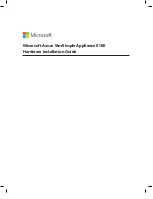
© 2015 Cisco and/or its affiliates. All rights reserved. This document is Cisco/Verizon Public Information.
Page 4 of 14
13. The dynamic Tunnel0 interface will have the IP maximum transmission unit (MTU) of 1476 bytes. IP packets
whose lengths exceed 1440 bytes will require fragmentation. For TCP traffic the
ip tcp adjust-mss
command
may be used as shown in this guide to avoid fragmentation. If the mobile router needs to handle large non-
TCP packets that have the Don’t Fragment (DF) bit set, a route-map that clears the DF bit should be applied to
the LAN interface of the mobile router.
14. Ensure that the
ip virtual-reassembly
command is not present on interface
Cellular 0/x/0
.
15. The Verizon Wireless Network will preserve the quality-of-service (QoS) markings (type of
service/differentiated services code point [ToS/DSCP]) that have been set in the original IP packet header.
16. The changes to the subnet (prefix) list registered by the mobile router take effect on EXGW immediately while
the NEMO session is running. No coordination is needed to advertise new subnets beyond ISR configuration.
17. While the Wireless/NEMO session is on periodic (~every 10 min) NEMO re-registration packets (~200 bytes)
will be sent by the router and replies sent by EHA. At all other times the backup connection state will be
maintained but the radio traffic channel will be in a dormant state.
18. The administrative distance for routes learned via NEMO (M routes) can be changed from the default value of
3. The “distance” command can be configured under the “router mobile” stanza.
19. Please refer to the notes in the configuration syntax for an explanation of the commands.
Design Requirements and Recommendations
1.
If an LTE connection cannot be made, the APN value on the LTE eHWIC modem should be checked (ISR
command
show cellular 0/x/0 profile
). If it is not the enterprise APN, please refer to planning section above.
2.
Although this configuration guide should be used first, additional information is available at:
●
www.cisco.com/go/4g under “Configuration and Deployment Guides”
●
LTE eHWIC (ISR G2) hardware overview, SIM installs, antenna connection, and module install:
www.cisco.com/en/US/docs/routers/access/interfaces/ic/hardware/installation/guide/EHWIC
-4G-LTEHW.html
.
●
LTE eHWIC (ISR G2) Cisco IOS Software configuration monitoring and troubleshooting:
www.cisco.com/en/US/docs/routers/access/interfaces/software/feature/guide/EHWIC
-4G-LTESW.html
.
●
LTE NIM (ISR 4K) hardware overview, SIM installs, antenna connection, and module install:
www.cisco.com/c/en/us/td/docs/routers/access/interfaces/NIM/hardware/installation/guide/4GLTENIM_HIG.html
●
LTE NIM (ISR 4K) IOS XE Software configuration guide
www.cisco.com/c/en/us/td/docs/routers/access/interfaces/NIM/software/configuration/guide/4GLT
ENIM_SW.html
●
The CGR-2010 LTE GRWIC is configured in the same manner as the LTE eHWIC.
































